Blue Dac 4,0 with four TDA1541A and NOS mode.
Evaluated and lampized in October 2009
Having the best transport that (my) money can buy - namely the CEC
TL-1X with all my mods; I think it is time to finalize the DAC
search.
I narrowed it down to the following choice of DAC chips:
1. Philips TDA1541A
2. AKN, AK439(X)
3. ESS Sabre DAC 900(XX)
4. AD1865
5. Wolfson WM8741
I already know well what the 2, 3 and 5 can do. Now the final round -
trying the 1 and 4.
Speaking of TDA1541 DACS - I have first fallen in love with the SATCH DAC, then I tried the Green Dac from
Analogmetrics, and now my last attempt - The Biggest DIY DAC in the
World - the mighty ..... ????... shit - this dac has
no name !
It is so blue that I am tempted to call it Bluedac.Or
Bloodac. Bloodac 4,0 .
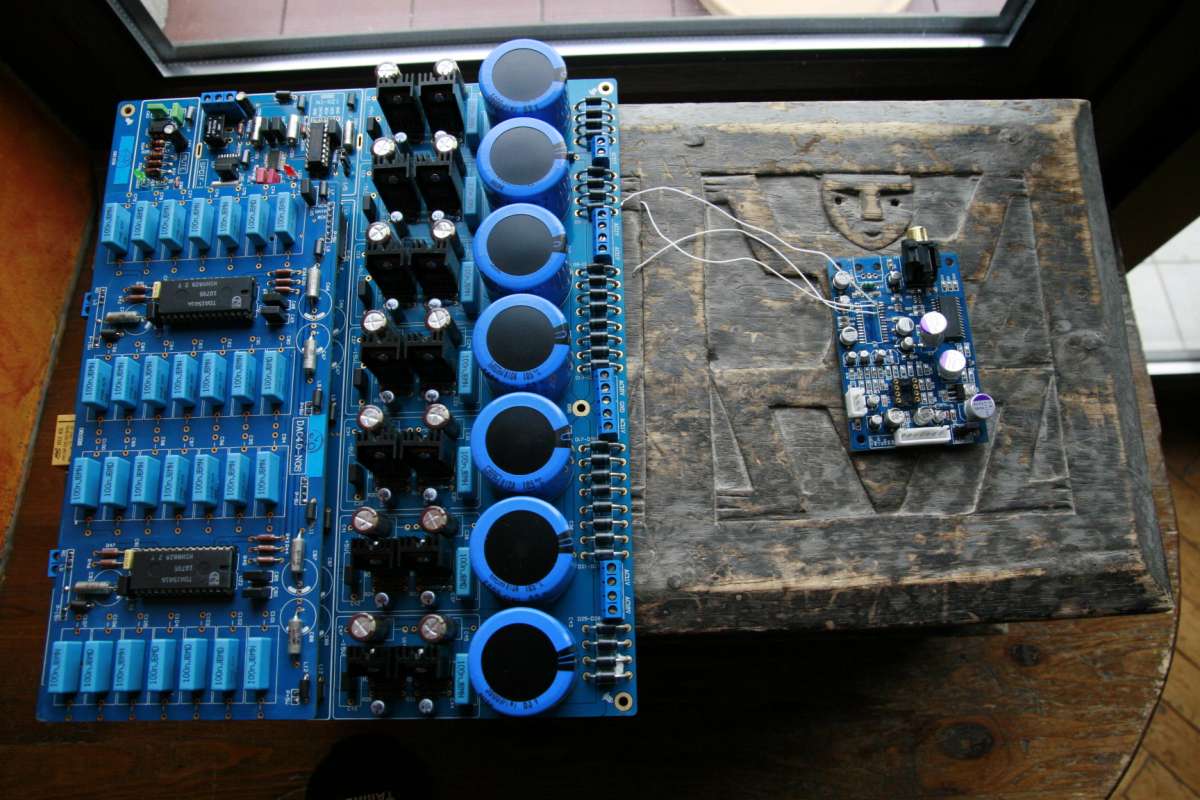
The Bloodac 4,0 against the baby Lampucera . You get the idea of scale
?!?! And the Bloodac has TWO PCBs one on top of another, which the
photo does not show. So in fact the area of PCB is like 1,5 of that on
the photo !!!
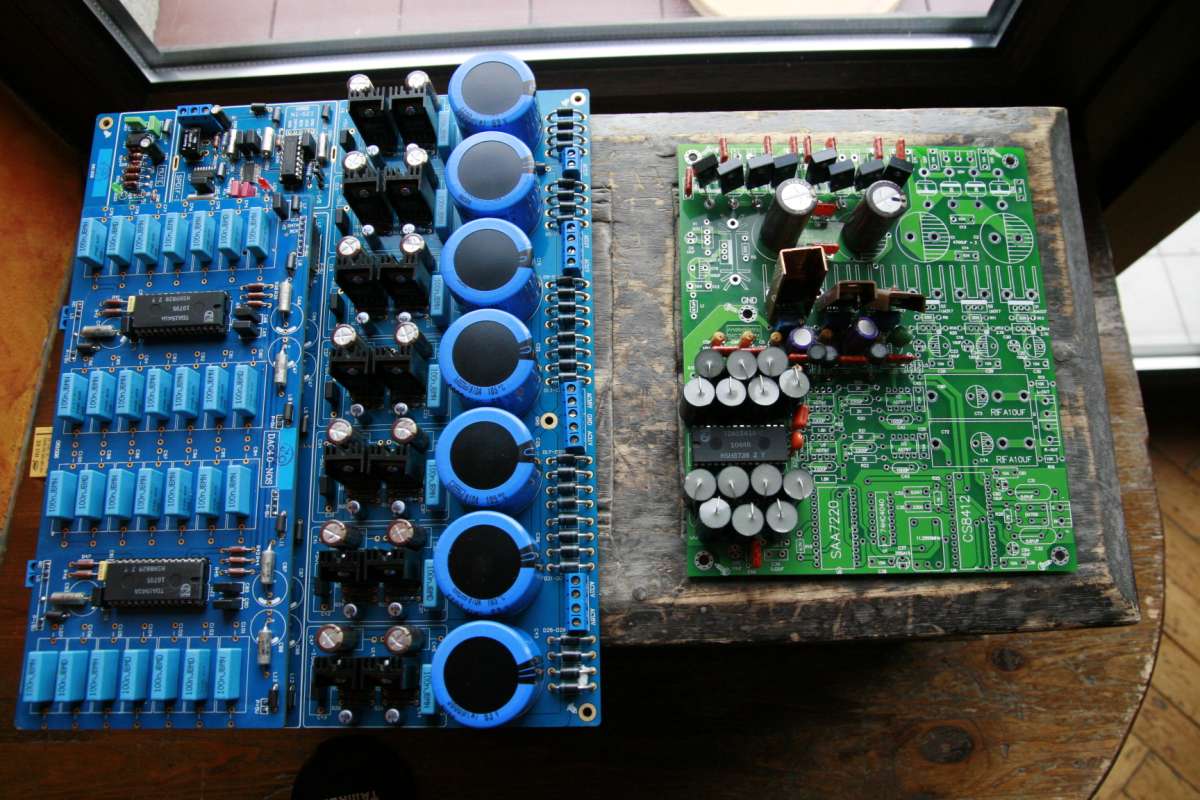
Here the green DAC against the Bluedac. The Green is still in Mute mode
because I am waiting for the receiver chip to arrive. Other than that
it is finished.
Basically both have the same schematics, as it cant differ much really.
TDA is a TDA and it needs what it needs.
The bloodac 4,0 is the latest design of them all and it is the
largest and also most costly.
In my opinion, the Bloodac 4,0 is NOT engineered honestly to play good
music. It is designed for the eyes to the concept like this:
The manufacturers of the BlooDAC4,0 talking:
"Hey guys, I checked the audiophile
forums, and I found that many people like TDA1541A, so let's make some
money on producing the most impressive DAC. People like TDA ? we'll
give em four. They like oversized power - we'll give them 5 kilo of
caps. People like NOS - well give em NOS. The regulation is considered
"cool" - lets throw in 14 regulators . People like separate
transformers - we'll provide 7. We can sell this stuff like crazy ...:"
This is the Fikus interpretation of the birth of the DAC 4,0.
I think that I know what Thorsten - perhaps the world's greatest
specialist in TDA department - thinks of this design. He probably
thinks it is full of crap. Well, him being a gentlemen, does not
put it like this I am sure. But that's what he thinks. The fourteen
caps are most far away from the TDA I have ever seen, and the key is -
that they must be close, right on the pins. The supply is made
GIGANTIC, which is missing the point. The dac has negligible
demand for quantity of power, it has huge demand for QUALITY. And the
quality - low noise - is not addressed. The money is wrongly spent -
just to impress the eyes. Never has so much been employed to
achieve nothing - my own paraphraze of the famous sentence.
Any good points ? Well, contrary to the Satch, Bloodac does not have
oversampling (that's good) and does away with the digital filter
SAA7220. (good) it also does not try to reclock the signal (good point
again). I am not sure about four chips, but surely having an option of
two is a point for bloodac again - against the Satch.
Bloodac 4,0 can be used as single chip, double, triple or quadruple -
any way we prefer, even with a switch. I kind of like that freedom.
Another point for Bloodac 4,0 - the money is not wasted on op-amped
output stage which we do not need. The analog stage is omitted (was the
Bloodac design commitee reading Lampizator pages perhaps ? )
I am fantasizing further - making each of the four DAC chips on
different set of caps - one Oscon, one blackgate, one Tantalum and one
- say - Russkij Militarnyj. (Voyennaja Tiechnika).
If the four sets were made switchable - I would have the good
comparator of caps on hand. With everything else being really equal.
Whichever way I will go - the DAC needs a serious listening session in
stock form first, then I will start with redesign of the ground
(critical issue) and then changing the 14 caps in each DAC to be very
closeto the pins and new ground wire and very low esr - a mix of
picofarad ceramics and something else like small vishay MKP or maybe 1
uF Oscon SMD.
Stay tuned to the follow up news.
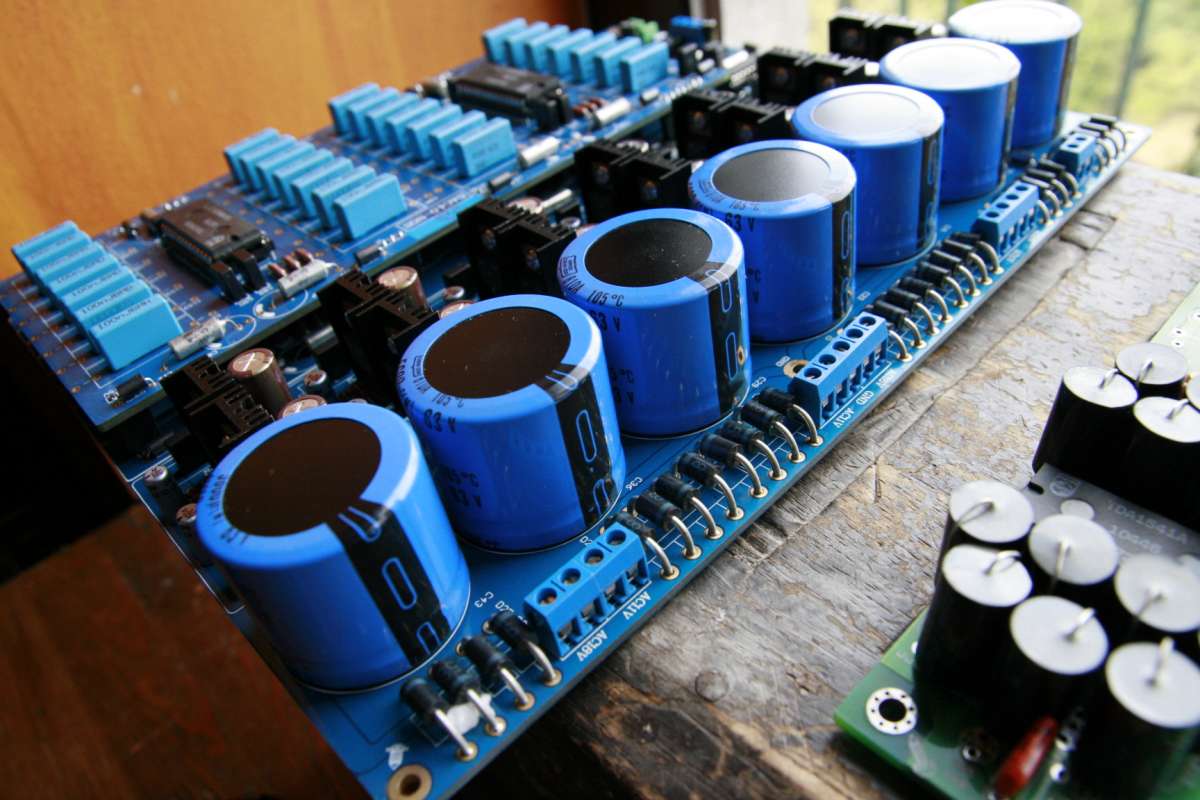
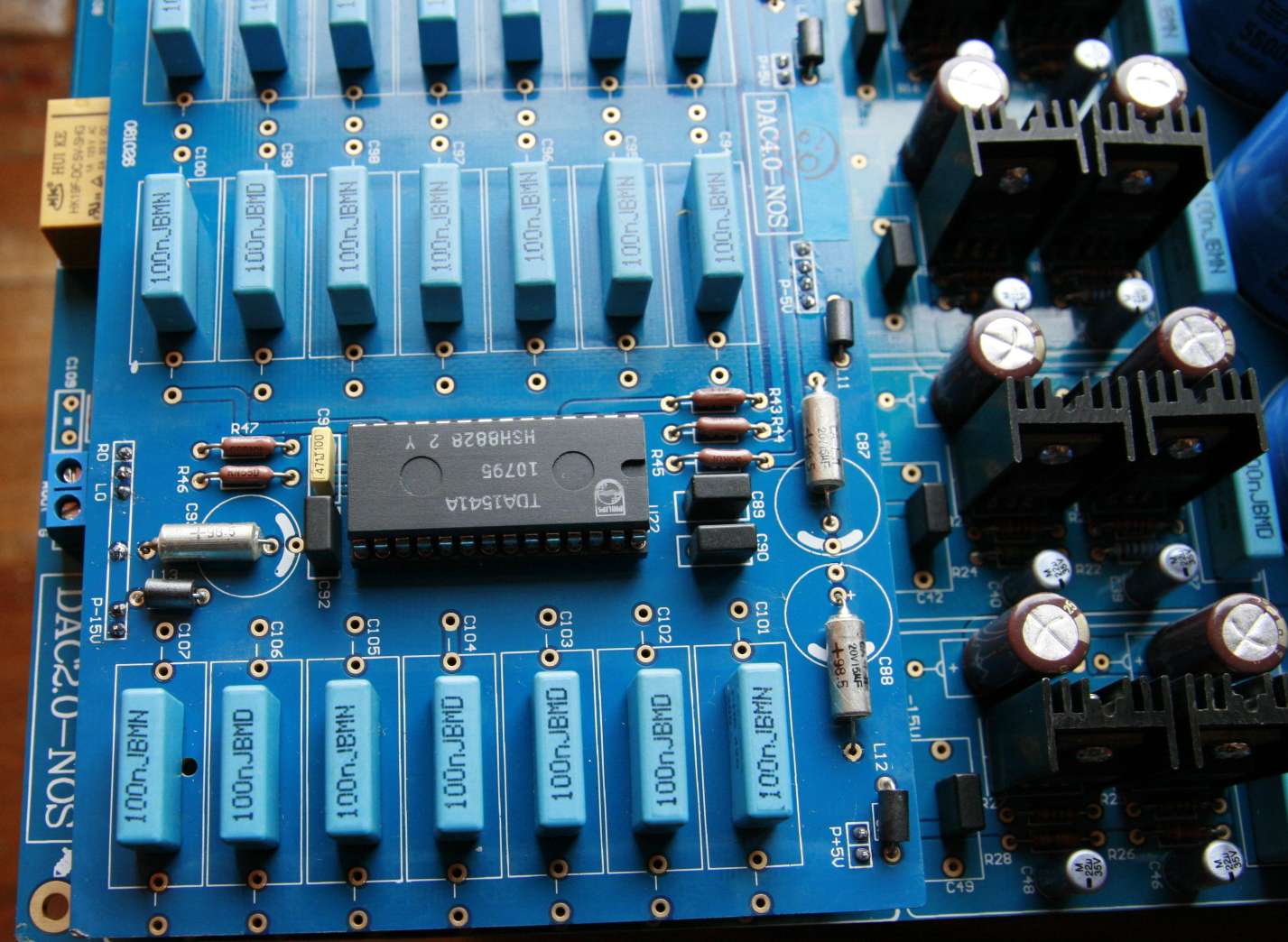
A month later
Ooops - another DAC was very well lampized by me - 5 evenings worth of
testing - and
finally I arrived at the following:
The lampized stock unit with SRPP stage added after output terminals -
sounded lifeless, dull, slow. Not really inspiring. If that was my
final sound for over 300 USD I would be really angry.
I started to remove the unnecessary stuff:
I removed the upper dual DAC board
and I made it a double TDA dac. Two is enough. I can recycle the add-on
board later - just add three power supply regulators : 7805, 7905, 7915
- and voillla - we have a ready i2S DAC solution, perhaps to work with
the squeezebox directly over the i2s.
I removed the digital input transformer. (Unnecessary by my book) .
I removed the digital chip with 14 legs - the buffering logic -
74HCxxx
which sits between receiver chip and DAC chips, and I went directlt
with the i2S signals to TDA legs 1, 2, and 3. Two
chips in parallel.
I floated the old inputs of i2s coming via three
DALE brown resistors. That HC74xxx was just wasting my time in that
circuit - its role was maybe maybe questionably necessary for 4 times
TDA, but not for 2.
I lifted completely the DAC pins 6 and 25 and wired them in parallel to
the tubes.
I used massive power supply with 8 secondaries and 4 cores in total.
I upgdraded 28 decoupling caps on the TDA and I also used oscons for
all supply decoupling close to pins 28, 26 and 15 of these chips.
I added 12 earth wires connecting all earth sections of that PCB. I had
a feeling that there is too much ground PCB too far away and on too
thin traces. So I built a real star from 0,7 mm copper wire.
That DAc - let me tell you - plays like a killer. It beats the SATCH
(almost the same scheme except one dac in the SATCH) and it generally
has very serious pretensions to be the best DAC that I know of. I am
now listening and already preferring it to the AD1865. Very very small
difference, but the TDA - being a TDA - has that something that no
other DAC has.
If they were women, AD1865 would be the pretty one, but the TDA would
be the pretty AND WISE one.
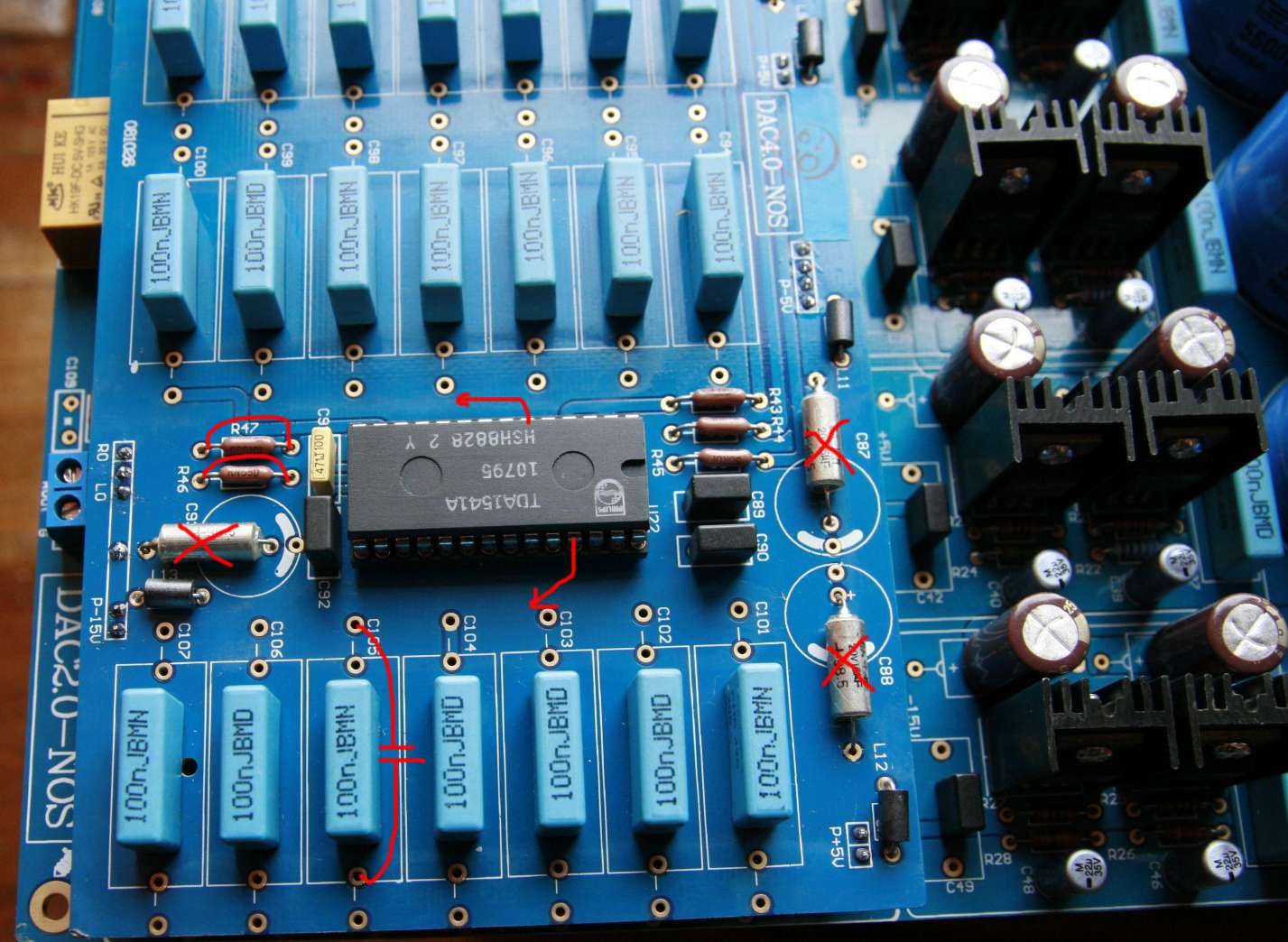
Just look: R46, R47 - MUST be shorted, thats a big design mistake. (on
all four DAC chips)
All blue caps must be bypasses with a quality capacitor like MKP - I
used small 600 nF - installed from the bottom - like shown on C105
above. Just across the blue caps. Thats 14 caps per DAC.
Ther silver C88, C87, and C93 were changed for oscons: for c87, 88 use
6 V oscons by some hundred microfarads, and for C93 - a 16 V version by
hundreds microfarads.
Floating of the outputs can be done by removing gently the DAC chip
from socket, bending out legs 6 and 25 and reinstalling the chip with
these two legs NOT GOING inside the socket. Then we solder thin silver
wire to these output legs directly.
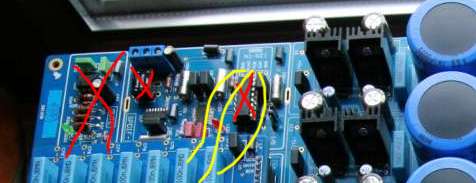
Above: my suggestion to remove the input transformer (and wire input
signal across the transformer legs after its removed.
Left red X is suggesting removal of that relay control circuitry - we
dont need relay - TDA is a chip "clean on mute".
I also suggest to remove the 74HCxxx chip (the one in the socket) and
wire the digital signal directly from the i2S soldering points: - like
the yellow lines suggest:
Word clock WCK to TDA leg 1
The DATA to TDA leg 2
The CLK or clock - to TDA pin 3.
And from there - to second TDA parallely.
That direct i2s mode works best for me. No need for glue logic
buffering amplifier 74HCxxxx .
ZE SOUND
This DAC is excellent - it really works like SATCH or better. It
is all that TDA is famous for - natural timbre, natural soundscene,
natural musical threads within the recording, and very fast transient
response. If anything at all can play like very best analog turntable -
this is it.
I tried many tubes at hand and finally I settled on a good old russian
6H1P (electrical equivalent of 6SN7GT. )
The R converter is now 38 Ohms.
Only the world very best machines with dual TDA and with NOS mod
applied can compare with this: Sony 227esd, Sony 337ESD, Grundig 9000
and of course the best NAIMs.
WHY NOBODY CAN PRODUCE SUCH GOOD DAC WITHOUT US HAVING TO SPEND 5
EVENINGS OF RISKY REWORKING?
How can I seriously recommend this to someone ? Out of the box -
this DAC was so far from perfection- why oh why ?!
If you feel competent to repeat what I did - GO FOR IT but save money
on the four dac version - go for otherwise identical TWO DAC VERSION.
Please get a huge cabinet - you gonna need lots of space to mount this
monster and 4 transformers.
The last trick I did which I dont recommend unless you are very good
with pump desoldering: I removed DAC sockets and I soldered chips in
place. For top quality - nothing beats direct hard solder.
I also for the hell of it - changed the chips to be TDA1541 non-A. I
just had a pair saved from last project. To my ears they may be a
little bit less laid back.

